The Intel SSD 320 Review: 25nm G3 is Finally Here
by Anand Lal Shimpi on March 28, 2011 11:08 AM EST- Posted in
- IT Computing
- Storage
- SSDs
- Intel
- Intel SSD 320
It's called the Intel SSD 320, but the part number should give away just what we're looking at here:
This is the long awaited third generation Intel based SSD. This is the G3. And at this point it's around 6 months late.
Back then it was simply called the Postville Refresh on Intel's roadmaps (Postville was the 34nm Intel X25-M G2). It would use 25nm Intel NAND, feature improved performance and full disk encryption - all behind a 3Gbps SATA interface.
When I spoke with Intel about the drive last year, all indications pointed to it being faster than drives based on SandForce's SF-1200 controller. And it is:
| Intel SSD 320 300GB vs. Corsair Force F120 | ||||
| AT Storage Bench 2011 (Heavy) | AT Storage Bench 2011 (Light) | |||
| Corsair Force F120 | 120.1 MB/s | 155.9 MB/s | ||
| Intel SSD 320 300GB | 132.8 MB/s | 161.7 MB/s | ||
Without turning to any real time compression/deduplication techniques, Intel has built a drive that's faster than the SF-1200. You also get that famed Intel SSD reliability:
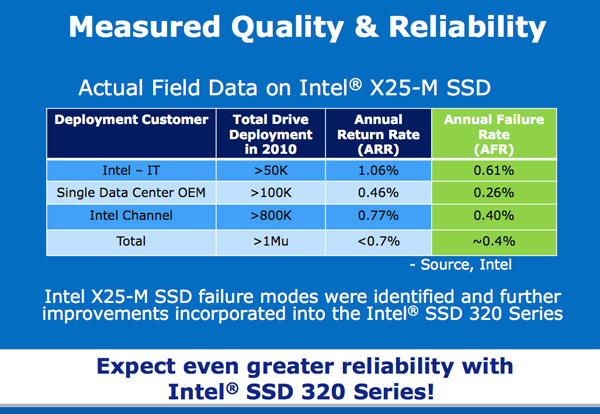
There's just one issue. The SF-1200 was the king of 2010. This year is shaping up to be all about the SF-2200 and the G3 isn't quite as competitive there. Intel realized this as well and thus we got the Intel SSD 510 to address the high performance market. Intel claims the 510 should have the same failure rate as the 34nm X25-M G2 at ~0.6% per year.
The Intel SSD 320 by comparison is aimed at the mainstream market. Remember that's what the M in X25-M always stood for to begin with. As a result we get lower pricing:
| Intel SSD Comparison | ||||||||||||
| X25-M G2 160GB | Intel SSD 320 40GB | Intel SSD 320 80GB | Intel SSD 320 120GB | Intel SSD 320 160GB | Intel SSD 320 300GB | Intel SSD 320 600GB | SSD 510 120GB | SSD 510 250GB | ||||
| User Capacity | 149GB | 37GB | 74GB | 111GB | 149GB | 279GB | 558GB | 111GB | 232GB | |||
| Random Read Performance | Up to 35K IOPS | Up to 30K IOPS | Up to 38K IOPS | Up to 38K IOPS | Up to 39K IOPS | Up to 39.5K IOPS | Up to 39.5K IOPS | Up to 20K IOPS | Up to 20K IOPS | |||
| Random Write Performance | Up to 8.6K IOPS | Up to 3.7K IOPS | Up to 10K IOPS | Up to 14K IOPS | Up to 21K IOPS | Up to 23K IOPS | Up to 23K IOPS | Up to 8K IOPS | Up to 8K IOPS | |||
| Sequential Read Performance | Up to 250MB/s | Up to 200MB/s | Up to 270MB/s | Up to 400MB/s (6Gbps) | Up to 500MB/s (6Gbps) | |||||||
| Sequential Write Performance | Up to 100MB/s | Up to 45MB/s | Up to 90MB/s | Up to 130MB/s | Up to 165MB/s | Up to 205MB/s | Up to 220MB/s | Up to 210MB/s (6Gbps) | Up to 315MB/s (6Gbps) | |||
| Price | $404 | $89 | $159 | $209 | $289 | $529 | $1069 | $284 | $584 | |||
It's still early in the 25nm ramp, but the 25nm Intel SSD 320 is cheaper than the 34nm Intel SSD 510. The only issue is that OCZ is very competitive with its pricing as well and compared to the Vertex 2, Intel's SSD 320 isn't really any cheaper. Intel likes to maintain its 65% profit margins so even though it makes the NAND and the controller in the 320, we're unlikely to see these drives drop below competitive pricing.
Intel expects the 25nm SSD 320 to be even more reliable than the 510 or X25-M.
The Same Controller
The Intel SSD 320, like the 310 and X25-M before it, uses an Intel branded controller. Opening up the 320 reveals a near identical controller to what we saw in the 34nm X25-M G2 housing:
You'll notice the part number is identical to 2009's X25-M G2 controller. In fact, it's the same controller. Apparently the G2 controller had a number of features on-die, but not implemented in firmware. Things like full disk encryption and NAND redundancy never made it out in G2 but are here in the 320 all thanks to new firmware. And no, G2 owners aren't getting it.
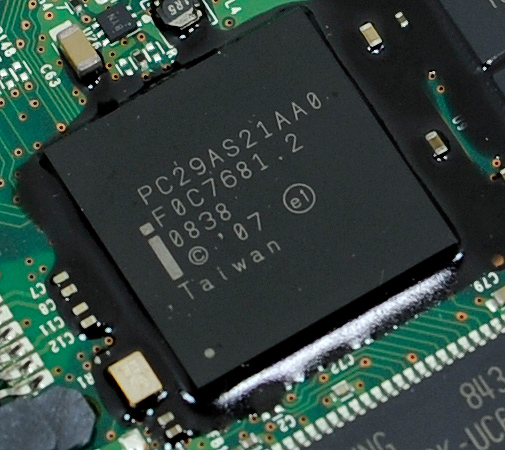
Intel's X25-M G1 Controller
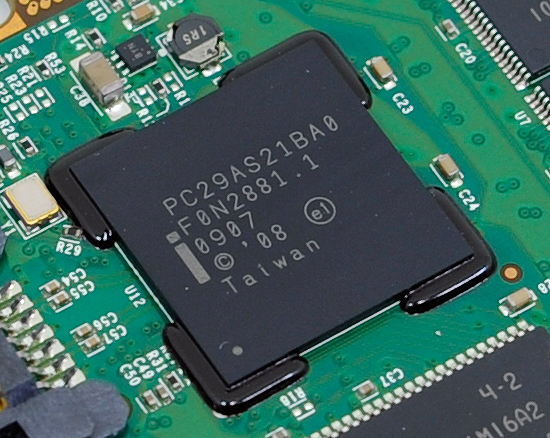
Intel's X25-M G2 Controller
Since the controller hasn't changed, the basic architecture of the SSD hasn't changed either. Intel still doesn't store any user data in its external DRAM cache and there's still a 256KB on-die SRAM.
Next to the Intel controller is a 64MB 166MHz SDRAM device, now made by Hynix. You'll notice that the DRAM chip is a lot smaller than what we've seen in previous X25-M generations, despite growing in capacity. Intel actually turned to mobile SDRAM for use in the SSD 320 to help save on power. While the X25-M G1 and G2 both used a conventional 3.3V SDRAM device, Intel moved to a 1.8V mobile SDRAM chip with the 320.
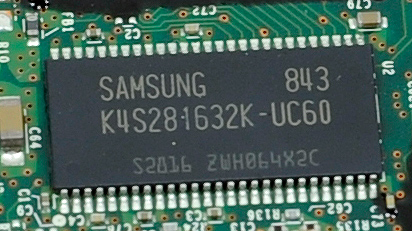
Intel X25-M G1: 16MB 166MHz SDRAM
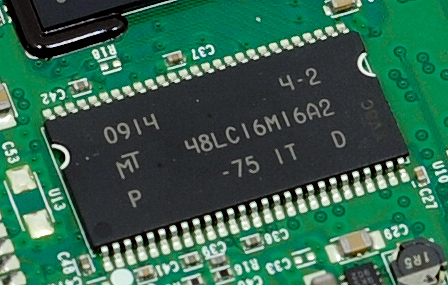
Intel X25-M G2: 32MB 133MHz SDRAM
Intel always prided itself on not storing any user data in its DRAM cache. The external DRAM is only used to cache mapping tables and serve as the controller's scratchpad. In the event of a sudden loss of power, Intel only has to commit whatever data it has in its SRAM to NAND. To minimize the amount of data loss in the event of a sudden power failure, Intel outfitted the SSD 320 with an array of six 470µF capacitors in parallel.
We've seen large capacitors on SSDs before, primarily the enterprise SandForce drives that boast a 0.09F supercap. Intel claims that for its design a single large capacitor isn't necessary given the minimal amount of data that's cached. It further claims that an array of multiple capacitors in parallel allows for much better reliability - if one capacitor fails the array is still useful (vs. a single point of failure in the case of the supercap).



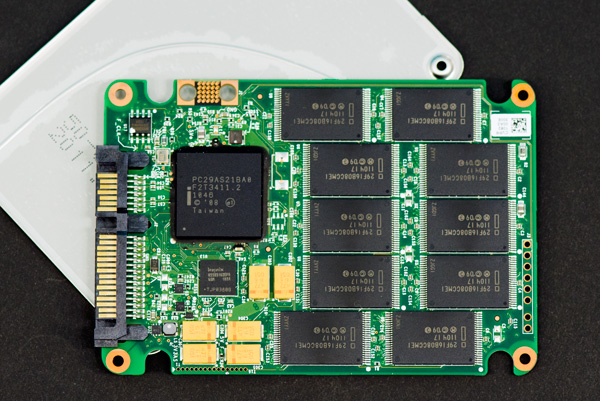
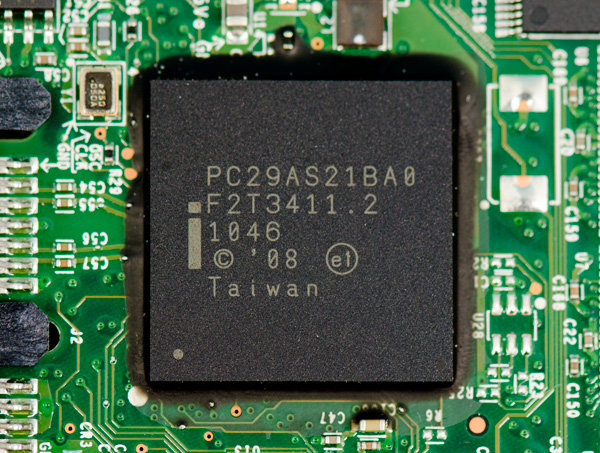
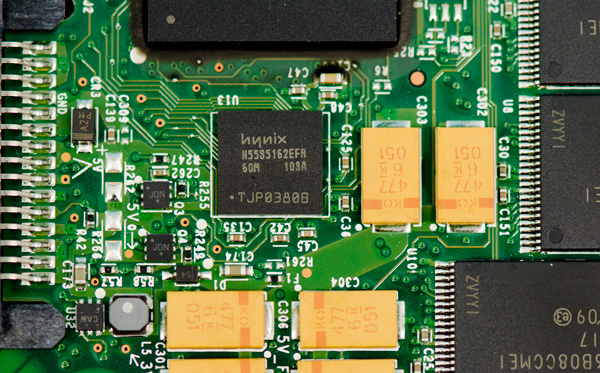









194 Comments
View All Comments
Ryan Smith - Monday, March 28, 2011 - link
Both the 120GB Vertex 2 and 300GB i320 are fully populated - each has all of their NAND channels in use. Intel does have a lane count advantage (10 vs. 8), but that's a design difference rather than how the SSD is populated. Thus on an architectural level it's fair to compare the controllers, as we're looking at the performance of both when they're fully populated and the architecture is not unnecessarily bottlenecked.Now at equal capacities this wouldn't necessarily be the case. Intel did not provide us with a smaller SSD, which is why Anand said "We also don't have a good idea of how much slower the smaller capacity drives perform in our benchmarks at this point.". It's safe to assume a 120GB i320 won't be fully populated and that it will have lower performance as a result. How much? We don't know.
crimson117 - Monday, March 28, 2011 - link
Thanks for the clarification! I appreciate your reply.I had missed the fact that each drive in the comparison has all its channels in use, so for example a 240GB SF-1200 would have higher capacity chips but would not have any additional channels to write across than a 120GB SF-1200.
Looking forward to the 120GB i320 review; it's much easier on the budget :)
ArteTetra - Monday, March 28, 2011 - link
i320? It sounds no good at all. Please call it with its name.GavinLeigh - Monday, March 28, 2011 - link
What we might have here is the kind of reliability (and hopefully pricing) to appeal to the notebook manufacturers. A 300Gb drive should be plenty for a road-warrior and the performance is definitely a plus over 7200rpm drives. Whole drive encryption could also add to the value in mobile applications.I think this is a smart drive, and I'll definitely consider it.
piquadrat - Monday, March 28, 2011 - link
How Full Disk Encription could add value in mobile applications when everyone can bypass ATA password within seconds using public available tools?DesktopMan - Monday, March 28, 2011 - link
See my response a page or two earlier. The password is used very differently for encrypted drives (that do cryptography correctly).tech6 - Monday, March 28, 2011 - link
While it won't win you bragging rights with your geek friends, the 320s do deliver something that has been missing from existing SSDs: Good enough performance, large capacities and reliability. The 1200 based drives had an unacceptable failure rate for most business/professional users and also couldn't deliver larger capacity drives. If the 2000 series comes in at the same price and is more reliable then Intel has problems and will need to discount but if its like the 1200 then Intel should sell a bunch of these.Chloiber - Monday, March 28, 2011 - link
I agree. The 320 is perfect for my notebook. Vertex 3 would be useless.y.a.k - Tuesday, March 29, 2011 - link
I agree. People say that it's a fail on Intel's part because it's slower than Vertex3. But I'm looking for an SSD for my work notebook, where reliability is even more important than speed. If this drive is as reliable as Intel says, then I'm getting it. And it's not like it's slow or anything.NCM - Tuesday, March 29, 2011 - link
Too many people seem to ignore that there are multiple markets for SSDs, and that they have different requirements beyond the basics. This leads to pointless discussions about the supposed merits of different SSD options. I see three main market segments, each with its own priorities:- Enterprise: Ultra high performance, and whatever you have to pay for that is simply the price of admission for your capacity and performance plan.
- Workstation: High performance boot/application drive, with the extra cost being quite moderate due to the relatively small size drive (~80-120GB) needed. Data can live on a secondary internal drive.
- Portable: Full capacity replacement for low performance standard drives. The typical single storage drive bay means that decent capacity at a reasonable $/GB is the key, not class leading performance.
(Note that reliability isn't a variable. I don't believe that any class of user will knowingly accept lower reliability than that offered by a conventional hard drive. Of course many have…unknowingly.)
This last category is the "good enough" requirement pointed out above by tech6. Sure, the Intel 320 may not be the most exciting new drive around, but notice that at $289 for 160GB or $599 for 300GB it's much less expensive than, say, the OWC Mercury Extreme at $599 for 160GB or—gasp!—$1619 for 400GB.
My own laptop drive is a 500GB with a over 300GB used, but with some housecleaning discipline I could live with the 300GB Intel. And in this application an SSD is like sex: even a bad SSD is good!
My Xserve uses an SSD boot/application drive, and I've set up one of our workstations similarly for evaluation. Boot and application launch times are, not surprisingly, 3-4 times faster with the SSD.